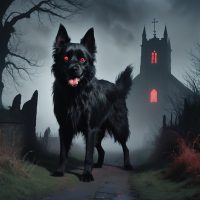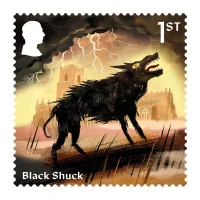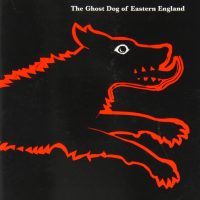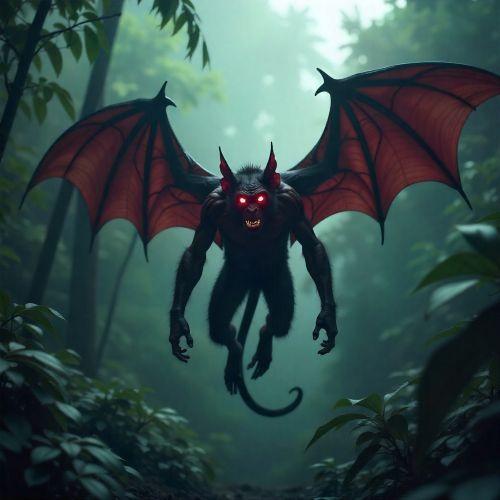Black Shuck : The Devil Dog
Listen
At a glance
| Description | |
|---|---|
| Origin | English Mythology |
| Classification | Hybrids |
| Family Members | N/A |
| Region | England |
| Associated With | Death, Invisibility |
Black Shuck
Introduction
In the mist-covered lanes and storm-battered coastlines of Norfolk and Suffolk, the legend of Black Shuck endures as one of England’s most chilling pieces of folklore. This ghostly black dog, with eyes that blaze like fire, is said to haunt churchyards, coastal paths, and lonely roads. For centuries, tales of its appearance have been interpreted as omens of death or disaster, a belief that has cemented its place in East Anglian mythology. The name itself comes from the Old English word scucca, meaning “demon” or “fiend,” underscoring its terrifying reputation. Although the earliest written records of Black Shuck date to the 19th century, its roots stretch far deeper, likely descending from a mix of Norse, Celtic, and Anglo-Saxon traditions that wove together tales of death spirits and spectral hounds.
Physical Traits
The image of Black Shuck is as unforgettable as it is terrifying. Most accounts describe it as an enormous black dog with matted, shaggy fur and eyes that glow a piercing red or green in the darkness. Some tales even claim it has only one eye, blazing like a burning coal in the center of its forehead. Witnesses have reported that the creature makes no sound as it moves, its paws leaving no tracks upon the earth. When it appears, it’s often accompanied by a sudden drop in temperature, a gust of wind, or a faint smell of brimstone—details that strengthen its association with the supernatural.
In a few cases, the hound’s physical form seems to defy natural law. It has been said to pass effortlessly through walls, doors, and gravestones, disappearing as suddenly as it arrives. Other reports describe its size as being comparable to that of a horse, its outline barely distinguishable from the night itself. Whether seen near churchyards, crossroads, or along the windswept cliffs of East Anglia, Black Shuck’s presence is enough to stop even the bravest traveler in their tracks.
Family
Unlike many mythological beings with genealogies and divine ancestry, Black Shuck stands alone – an isolated phantom without parents, kin, or lineage. Yet it belongs to a wider “family” of spectral black dogs that appear throughout Britain and Northern Europe. In Yorkshire, it’s known as the Barghest; in Wales, as the Gwyllgi; in the Isle of Man, as the Moddey Dhoo; and in Northern England, as Padfoot or Skriker. These legends all share a common thread: the appearance of a ghostly black hound as a messenger between worlds, an omen of death, or a protector of sacred places.
Folklorists have long speculated that such myths may have originated in pre-Christian traditions. In Norse mythology, the great hounds Garmr and Fenrir guard the gates of the underworld, while Celtic legends often portray dogs as guardians of the dead. The enduring image of the black dog in English folklore may therefore be a fusion of pagan beliefs, later reinterpreted through a Christian lens as symbols of the devil or restless spirits.
Other names
Throughout East Anglia and neighboring counties, Black Shuck is known by a host of names that reflect both local dialect and evolving folklore. It is variously called Old Shuck, Shock, Shug, Shuck Dog, or The Devil’s Dog. In some rural tales, it’s referred to as The Churchyard Beast or The Hateful Thing. The term “Shuck” likely stems from scucca, the Old English word for demon, but it may also connect to the word shuck meaning “to frighten.” These variations reveal the flexibility of oral storytelling, where each village or region added its own flavor to the myth.
While Black Shuck is the best-known of England’s spectral hounds, it’s far from unique. Similar black dog figures, like the Barguest of the North or the Gytrash of Lincolnshire, hint at a shared cultural archetype – a supernatural canine that straddles the line between protector and predator, between this world and the next.
Powers and Abilities
The supernatural abilities attributed to Black Shuck are as varied as the legends themselves. Most consistently, it is described as an omen of death: those who see it are said to experience tragedy or misfortune within a year. The hound’s spectral nature allows it to appear and vanish without a trace, sometimes emerging from mists or lightning storms. Its eyes glow with an otherworldly light, and its mere gaze is said to paralyze onlookers with terror.
Yet not all depictions paint it as purely evil. Some tales suggest Black Shuck serves as a guardian spirit, protecting lost travelers from harm or guiding them safely home through the dark. This duality – both benevolent and malevolent – reflects humanity’s complex relationship with the unknown. The creature’s ability to inspire fear and awe simultaneously has helped it survive across centuries of retelling.
Among its most famous appearances is the event of August 4, 1577, when, according to legend, Black Shuck burst through the doors of St. Mary’s Church in Bungay during a violent storm. It was said to have killed two worshippers and left scorch marks on the church door—marks that can still be seen today. That same day, it reportedly appeared in nearby Blythburgh, again leaving its ghostly signature. These incidents transformed Black Shuck from a regional myth into a lasting symbol of divine or demonic intervention.
Modern Day Influence
Far from fading into obscurity, Black Shuck has become deeply embedded in modern British culture. The legend has inspired countless books, films, and songs – most notably the British rock band The Darkness, who paid homage to the creature in their debut album. The hound also prowls through the pages of gothic novels, fantasy stories, and ghost-hunting documentaries. Writers such as M. R. James and contemporary horror authors have reimagined Shuck as a spectral guardian or a misunderstood soul, bringing psychological depth to an ancient myth.
In East Anglia, the legend continues to shape local identity. Pubs, breweries, and walking tours proudly bear the name “Black Shuck,” turning folklore into a living tradition. Statues, murals, and plaques commemorate its haunting presence, and the towns of Bungay and Blythburgh still draw tourists intrigued by the famous church incident. Even in paranormal circles, reports of large, glowing-eyed dogs persist, blurring the line between myth and modern-day mystery.
In popular culture, Black Shuck’s image resonates beyond folklore – it appears in video games, poetry, and even discussions of cryptozoology. It symbolizes the primal fear of what lurks unseen in the dark, but also the enduring power of storytelling to transform terror into heritage.
Related Images
Source
English Heritage. (2023). Black Shuck – East Anglia’s Spectral Hound. Retrieved from https://www.english-heritage.org.uk/visit/places/black-shuck/
Cake, A. (2022). Folklore and supernatural legends of East Anglia. Suffolk Press.
Hutton, R. (2015). The Pagan Religions of the British Isles: Their Nature and Legacy. Wiley-Blackwell.
Simpson, J., & Roud, S. (2016). A Dictionary of English Folklore. Oxford University Press.
Briggs, K. (1970). The Fairies in Tradition and Literature. Routledge.
James, M.R. (1904). Ghost Stories of an Antiquary. London: Edward Arnold.
BBC. (2019). The Legend of Black Shuck: Truth or Folklore?. Retrieved from https://www.bbc.co.uk/news/uk-england-norfolk-48230549
Storey, L. (2021). Ghost Dogs and Black Shuck: An East Anglian Myth Retold. Mythos Mysteries Publishing.
Frequently Asked Questions
What is lorem Ipsum?
I am text block. Click edit button to change this text. Lorem ipsum dolor sit amet, consectetur adipiscing elit. Ut elit tellus, luctus nec ullamcorper mattis, pulvinar dapibus leo.
What is lorem Ipsum?
I am text block. Click edit button to change this text. Lorem ipsum dolor sit amet, consectetur adipiscing elit. Ut elit tellus, luctus nec ullamcorper mattis, pulvinar dapibus leo.
What is lorem Ipsum?
I am text block. Click edit button to change this text. Lorem ipsum dolor sit amet, consectetur adipiscing elit. Ut elit tellus, luctus nec ullamcorper mattis, pulvinar dapibus leo.
What is lorem Ipsum?
I am text block. Click edit button to change this text. Lorem ipsum dolor sit amet, consectetur adipiscing elit. Ut elit tellus, luctus nec ullamcorper mattis, pulvinar dapibus leo.
What is lorem Ipsum?
I am text block. Click edit button to change this text. Lorem ipsum dolor sit amet, consectetur adipiscing elit. Ut elit tellus, luctus nec ullamcorper mattis, pulvinar dapibus leo.









